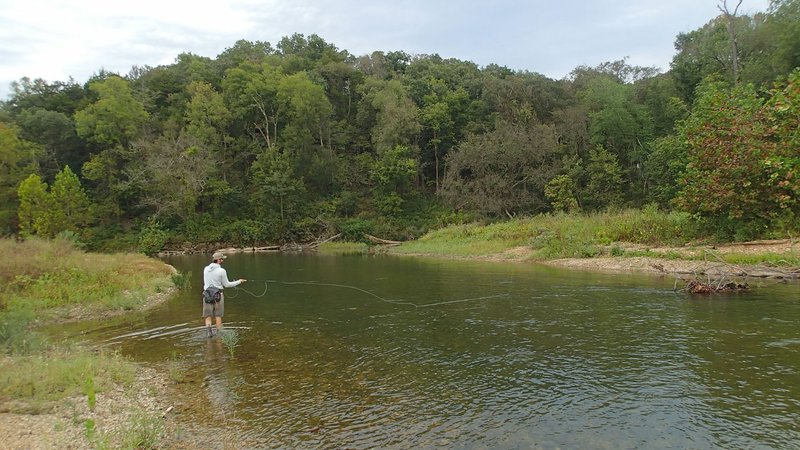It's no-frills fishing when Daniel Roberts heads to the river to catch smallmouth bass.
There's no kayak, no paddle, no need to shuttle a vehicle. On the water, he doesn't burn a drop of gas or tote a suitcase-sized tackle box. There's just Roberts, his fly rod and his feet.
Where to wade
The region’s streams offer public access for wading and fishing. Here is a sample.
• Kings River: Stony Point access along Arkansas 143 near Grandview, or any public access.
• War Eagle River: Withrow Springs State park, where Arkansas 23 crosses the stream.
• Big Sugar Creek: Deep Ford access east of Pineville, Mo.
• Elk River: Mount Shira access east of Noel.
• Illinois River: Chamber Springs access along U.S. 412 east of Siloam Springs.
Wading a quiet Ozarks stream is Roberts' way of tempting the feisty smallmouth and largemouth bass that patrol the clear water. He wears shorts when the water's warm and laces up boots made for wading.
The only accessory is a pouch full of colorful fishing flies the 25-year-old from Springdale ties himself. Some imitate crawfish. Others mimic minnows. All look like a bass could jump right out of the creek and snatch a fly right out of Roberts' hand.
Little Sugar Creek near Pineville, Mo., is where Roberts likes to get his boots wet. The stream skirts Bentonville and bisects Bella Vista before meandering into Missouri. It sweeps north of Jane, Mo. and joins Big Sugar Creek at Pineville to form the Elk River.
Sycamore trees along Little Sugar showed traces of yellow on an overcast Wednesday, Sept. 25, when Roberts stepped into the creek. Recent rain had the stream at an ideal level at Griffith bridge, a concrete slab that crosses Little Sugar north of Jane in McDonald County, Mo. The low-water bridge is at the junction of White Bluff Road and Skaggs Hollow Road north of Jane.
Clear water poured through two big metal pipes at the bridge. Roberts braced his boots on the slab and landed his first cast inches downstream of the pipes
"There's some absolute giant fish in these outflows," Roberts coached on this mild, overcast morning. Slowly, he worked his way downstream arching artful casts with his limber fly rod. Bright-colored fly line curled behind him, then shot out straight, carrying a crawdad fishing fly through the air.
Roberts likes a short fly rod for stream fishing because of trees and vegetation along the shore behind him while he fishes. His go-to rod measures 7 feet, 11 inches long, shorter than the 9-footers that fly fishermen often use.
In the clear water, Roberts could see where a shoal of pebble-sized gravel dropped off into a pool about 4 feet deep. The crawdad fly splashed down and sank quickly, but didn't hit bottom before a smallmouth bass nabbed it.
The fighter put a deep bend in the fly rod as the bronze-colored smallmouth neared Roberts' bent knees and outstretched palm. A quick twist of the hook freed the barb and the smallmouth was gone fast as a stone out of a sling shot.
"I like to tie my flies heavy so they get to the bottom quick," he said. A 6-weight fly rod is ideal for casting larger flies designed for catching the three species of black bass -- smallmouth, largemouth and spotted.
In the fly fishing world, a 6-weight rod is a size medium, not too light or too heavy. It's ideal for bass fishing. He ties his flies to 8-pound test leader -- 3X in the jargon of fly fishing -- that's strong enough to tame hard-fighting bass.
Crawdad flies catch fish near the stream bottom, but Roberts works the surface, too. He uses floating popper-style flies that splash and dance, created by his own hands.
Watching Roberts wade a stream is a clinic in thorough fishing. Floating in a canoe or kayak, an angler might make one or two casts at a spot as the boat drifts downstream. A wade fisherman can plant two feet in the gravel and make cast after cast. Sometimes that's what it takes to get fish to bite, especially Mr. Big. Roberts proved it near the end of the morning.
By now he'd waded a half-mile downstream of the low-water bridge. His attention was riveted on the root wad of a fallen tree in an oblong driveway-size hole of water. Roberts stood his ground, or his gravel, 10 yards away from the gnarly network of woody roots.
His popper fly hit the same spot cast after cast, like an archer piercing a bull's eye time and again. Four casts, six casts, then eight. Finally, Roberts' fly vanished in a whirlpool born by the maw of a big bass.
Roberts had a tiger by the tail, or the jaw. The angler dug in his heels and pretty soon cradled the hefty largemouth bass in his hands. The bass looked to be 2 to 3 pounds. That's big for a stream-born largemouth.
"He hit that after I'd cast to the same spot about 10 times. It just goes to show you that it's good to keep on casting." Roberts said, releasing the trophy.
Surface fishing with popper flies on a stream is best at dawn, dusk and cloudy days, Roberts said. Anglers welcome an overcast sky, such as the one veiled over Little Sugar Creek on this September day of no-frills fishing.
Sports on 10/22/2019
